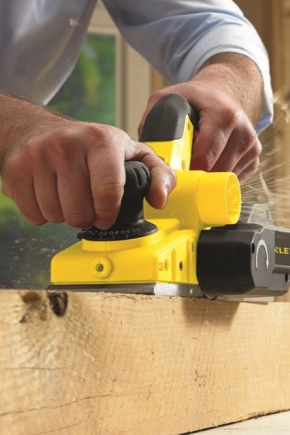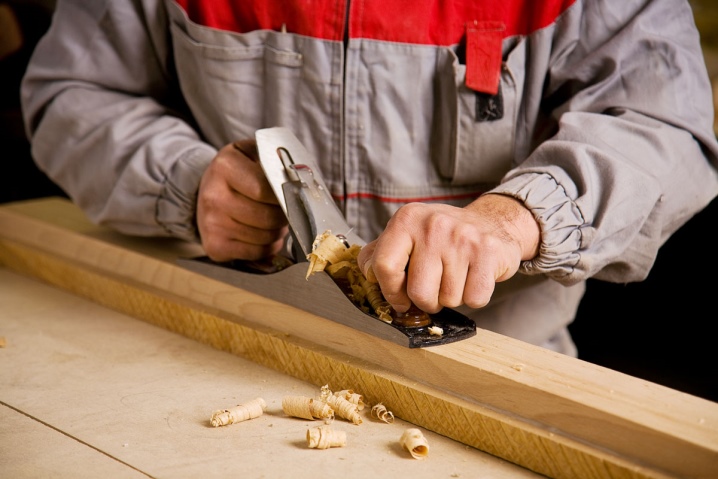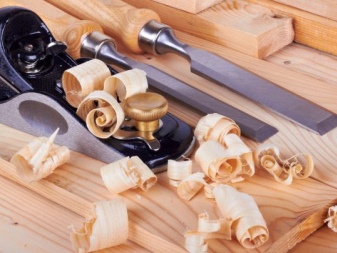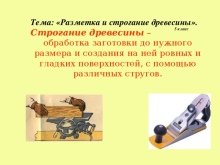Planing wood: types and tools

Wood is one of the most demanded materials used by man since ancient times. Houses, various structures are built from it, and extensions are erected. Wood is used as a base for various products and objects. A in order for the "craft" to be of high quality, it is necessary to properly process the material. To date, several methods of wood planing have been developed, and each of them has certain features and some disadvantages.

What it is?
Planing wood - processing wood by removing shavings. The working process is accompanied by the reciprocating movements of special tools with planing cutters, which are colloquially called knives. Each movement of the tool involves the removal of a layer of wood rolled into chips. The return stroke of the cutter is characterized as a mini-preparation for the next working stroke. This cycle lasts until the surface of the wood acquires the required shape and smoothness.
The material receives a quality surface only if an adjusted planer with one or more sharp knives was used for the work.
Another factor affecting the quality of planing is the direction of the chip removal in relation to the wood fiber. In this case, 3 options are considered, namely: planing along, across and at the end.


The method of processing along the grain is often used. In this case, the surface of the wood is as flat and smooth as possible, which meets the requirements of high quality. The method of processing transverse planing is in many ways inferior to the option of removing a layer of wood along the grain, since the finished surface has some roughness. Most often, the cross planing method is used for roughing wood.
The most difficult is the planing of a tree at the end. This method involves cutting the wood layer perpendicularly using increased pressure. However, without dexterity, it will not be possible to get a perfect cut.
And yet, if there is a need to make an end cut, you will need to stock up on thin freshly sharpened knives for the cutter.


The ways
To date, two main methods of wood processing have been developed: manual and automatic. The second type of processing is also called mechanical. The manual method is fully used at home, while the automatic version is used on a production scale. And in order to fully understand the existing types, it is proposed to learn more about each planing method.


Manual
This method of wood processing involves the use of manual labor. The wooden blank is carefully examined, the direction of the fibers, layers and the level of roughness are determined.
The manual method is designed for planing by layer. In simple terms, towards the exit of the cut layers and oblique fibers. Having correctly determined the direction, the process of work becomes simpler, and the surface receives a minimum roughness.
It is very important that the material to be processed is firmly fixed and tightly adhered to the base of the workbench. AND only after that you can proceed to the main stage of work.
The main thing is to follow the safety rules.


Auto
This method of wood processing is often used in production. For this, special equipment has been developed - an electric plane. The main condition is that the processed wood must be dry and free of dust. In the equipment itself, certain parameters should be set so that, when it comes into contact with a tree, the device does not produce sharp jolts that could spoil the material being processed.


Instruments
Equipment designed for wood planing falls into 2 categories:
- hand tools;
- automated or mechanized tools.
First of all, it is necessary to clarify that the degree of cleanliness of the final surface is manually divided into several types. Rough planing is done under a scherhebel, a plane allows to achieve average quality, and clean planing is done under a jointer.
Hand tool models can be purchased at any hardware store. Moreover, they are necessarily present in the dacha inventory.
Such tools are considered versatile, as they have a wide range of actions.


When it comes to hand tools, the first thing that comes to mind is the plane. It is used to process a rough sample of wood to give it an even and smooth surface. However, if the blades of the planer are dull, it will be impossible to obtain a quality base.
Another significant instrument is the scherhebel. It is intended for primary processing of "black" material. Its knife has a rounded shape, which greatly facilitates the process of removing layers from a wooden surface.
In the places where the scherhebel is processed, hollows appear, thanks to which the base gets decorative.


The list of mechanical tools for planing wood includes an electric planer. It is used to obtain the most even and smooth surface. This device is capable of processing rough wood samples.
Mechanical devices have a number of positive aspects. And first of all, it is the speed of planing parts in their final form. With a plane, the work process will take a very long time, especially if the number of parts exceeds its capabilities.
Today, several models of electric planers are in great demand.



IE-5707A-1
This model is mainly used in carpentry workshops. It consists of an electric motor, cutters with replaceable knives, skis of the movable and fixed types, as well as the head and the handle. The essence of the technological operation occurs according to the following principle:
- the rotor of the electric motor starts to rotate;
- torque is supplied to the cutter;
- planing begins.
This machine is equipped with a planing depth adjustment function. To set this parameter, you will have to raise or, conversely, lower the ski.
What is noteworthy, this machine is designed both for processing a rough sample of wood, and for the final adjustment of the product. You just need to change the grooved cutter to a flat one.


IE-5701A
This model of an electric planer has practically the same "stuffing". The only difference is that instead of a cutter, there is a knife shaft in the design, which allows planing of any complexity.
A chisel is considered an important tool for planing wood. With its help, it is possible to modify the elements of the part, where the plane and mechanized equipment cannot reach.


Stages of work
The main essence of wood planing is to create a smooth surface of the material, eliminate defects that arise after sawing. Sawing is called cutting wood, where the direction of the straight line corresponds to the direction of the translational movements. From this it follows that sawing and planing are the main processes of wood processing
Sawing involves dividing wide planks into strips. When sawing, it is important to correctly position the material, otherwise further processing will take much more time and effort.
Planing wood is a process that allows you to change its shape and size. Wood is generally considered a very demanding base. That is why its processing takes place in several stages. The first involves drying wood. If the wood is damp, then in the near future the resulting product will lose its appearance. Then cutting is done, grinding, and then mechanical or manual processing.
This sequence of actions may vary, it all depends on the properties of the raw materials used.


The planing technology of the processed wood depends on the shape of the surfaces. Planar planing involves working with parts of a square and rectangular section, and figured planing is characterized by the creation of curvilinear outlines.
Waste, by the way, is not thrown away. They are sent for processing, after which they are turned into building materials and much more.
Those who have no experience in wood planing should get acquainted with the theory and study several master classes. These lessons will show you how skilled craftsmen plan complex shapes. Experts will tell you what the thickness of the cut layer depends on, explain how to grind the product.
For primary practice, it is recommended to choose pine lumber.

Preparation
Preparatory work is divided into carpentry and finishing. The former include sealing cracks, cleaning the entire surface and sanding. But it should be remembered that wood embedding is carried out only when the finished product must be painted in other colors. But with finishing preparation, everything is much more complicated. This process consists of several stages:
- leveling the surface of the wood;
- obtaining an expressive texture of the material using bleaching, dyeing or resin removal;
- strengthening of the parameter of wood hardness.
Next, you need to clean the wood from dirt and dust. Only after that you can proceed to the next stage of work.


Markup
It is impossible to do anything without markup. This step involves transferring dimensions, volumes and shapes from a paper drawing to a material, in this case wood.
Without a markup, but relying only on your instincts, it will not be possible to make a beautiful and high-quality product. The finished elements can be different in shape, do not connect with each other and, in general, do not correspond to the intended design.
To apply the markup, you will need several tools, namely: a pencil, ruler, square and tape measure. Complex details may require the use of a compass.



Planing
Using the manual method of wood planing, it will be possible to obtain a flat surface where there will be no dents, chips or other defects. For work, you will need to take a scherhebel, a plane and a jointer. Everyone knows that the external parameters and the principle of operation of these instruments have a lot in common. They remove fine chips from the surface of the wooden base.
When working with hand tools, you must follow the rules of use. For convenience and safety, the device should be held with both hands and pressed against the surface to be treated with full force. The material should be firmly fixed on a workbench or similar.


The area in front of the wood should be planed. Once the initial section has passed the processing procedure, the master must take a step back and begin to plan the further part of the material, adjusting it to the finished base.
When working with hard woods, planes at a slight angle across the grain. With this approach, the surface will not get perfect smoothness, but the material will not be damaged.
To prevent the removal of the layer from the wood from being too thick, the front part of the planer should be firmly pressed against the surface to be treated, and the rear part of the tool should be slightly raised.



Grinding
Thanks to the sanding procedure, the wood base gets a perfect smoothness. Even small roughness, almost imperceptible to the touch, is removed from its surface.
The manual method of sanding involves using sandpaper with different grit values. You can hold a piece of it in your hand, but during work there is a high probability of getting abrasions. It is best to use a wooden holder.
The wood sanding process takes place in several stages.
- Rough sanding. For work, coarse-grained sandpaper is used. With its help, it is possible to level the surface of the product.
- Polishing work. In this case, you should use sandpaper with an average grit index - 100 will be enough. It will allow you to remove the pile formed after rough grinding from the surface.
- The final touch. For work, sandpaper with fine grain is taken. It removes imperceptible defects and brings the product to the stage of varnishing.
For sanding hardwoods, sanding is used. This is one of the varieties of grinding work. The manual method of scraping involves the use of a scraper - an insert with a blade that is 1.5 mm thick and a sharp working tip. The looping technology is actually very simple.
The tool is held with the fingers of one hand, is set at a right angle, and the wood layer is removed by the type of scraping.



Safety engineering
For some people, planing wood is an element of their main work, for others it is a hobby or hobby. But in one case or another, it is important to observe safety precautions.
The basic rule of carpentry is the use of sharp tools. But it is precisely the sharp knives and blades that are especially dangerous to humans. That is why it is important to keep track of your actions and progress of work. The sole of hand tools must be flat, free of chips, tears and similar defects.
When using a plane, it is important to follow the rules of safe work. When disassembling the tool, it is necessary to hold the tip with the finger of your left hand, and the palm and the rest of your fingers should be placed on the sole of the device behind the location of the knife. Strike the cork of the planer should only be done with a mallet. A metal hammer can damage the tool, and if it bursts, there is a high chance of injury with the blade. When assembling the plane, the blade should be inserted together with the wedge. At the end of the assembly, it is necessary to check the installation of the knife.
If it is skewed, you may be injured.


The process of planing with a plane that does not have an emphasis in the design should be carried out with extreme caution. In no case should you press your right hand against the blade, otherwise painful abrasions will appear. During rest, the plane should be put on its side with the sole away from you. This does not spoil the edge of the knife, while there is no chance of cutting yourself, grabbing the tool again.
As for the material to be processed, the wood should be firmly pressed against the workbench. It should not bend and slide on the work table.
Safety regulations must also be followed with mechanical equipment.
Failure to take precautions can lead to disastrous consequences.

You can learn how to plan frozen wood in the video below.













The comment was sent successfully.